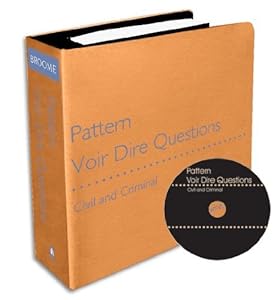
As Professor Kaufman states in the video below, the most important part of any jury trial is the Voir Dire process. Voir Dire is the process by which attorneys select, or perhaps more appropriately reject, certain jurors to hear a case. The Voir Dire process can be daunting to an experienced trial attorney, let alone a new trial attorney. A well prepared trial attorney can focus on having a conversation with potential jurors and focus not only on their verbal responses but also their nonverbal behavior.
There are two stated purposes for the Voir Dire process: (1) to determine whether any potential jurors should be disqualified or challenged for cause; and (2) to obtain information for use in exercising preemptory challenges. However, any experienced trial attorney will say that there is a third, unstated purpose to Voir Dire: to being to present his or her side of the case to the potential jurors and attempt to sneak in a touch of argument against opposing counsel's case.
This guide provides resources that provide an overview of Voir Dire law in Missouri. The resources provided by this guide include written and online secondary source material, sample forms and questionnaires, and sample Voir Dire transcripts. The video below helps demonstrate the basic principles of Voir Dire and to demonstrate how to Voir Dire a juror.
One of the most important things that every attorney conducting a voir dire needs to know is the law surrounding voir dire. Every jurisdiction is slightly different, but the main principles are the same.
There are certain questions that cannot be asked during the voir dire process. One of the most authorative Missouri cases on this topic is State v. Clark. 981 S.W.2d 143 (Mo. 1998) (en banc). Hypothetical questions, for instance, can be asked during voir dire; however, the questioner must be careful not to commit the potential juror to a side of a potential theory. An authorative Missouri case on this topic is State v. Roberts, 709 S.W.2d 857 (Mo. 1986) (en banc). For more information on this topic, see research assignment two.
Objections can be made during the voir dire process just as objections are made during witness examination. For an authorative Missouri case on this topic, see State v. Kreutzer, 928 S.W.2d 854 (Mo. 1996) (en banc). For more information on this topic, see research assignment three.

Voir dire is arguably the most important part of the jury trial process. An attorney who has never conducted a voir dire needs to first know and understand the law in her jurisdiction. Then the attorney should prepare herself with a questionnaire and a panel chart for use during the voir dire process. Finally, the attorney should have a list of basic questions ready to ask a potential juror.
There are other ways an attorney can prepare herself for voir dire. Reading any of the articles in this libguide will help an attorney prepare for voir dire. Further, reading an actual voir dire transcript will also assist the attorney with the flow of a voir dire.
The voir dire process is only as hard as you make it. Enjoy conversing with your potential jurors and start your jury trial with a positive experience!
This guide was originally created in support of Professor Diamond's Advanced Legal Research class for Spring 2014. The contents of this guide should not be taken as legal advice or as the work product of MU Law librarians.
 Pattern Voir Dire Questions
by
Pattern Voir Dire Questions
by
First and foremost, a trial attorney should associate him or herself with the Voir Dire statutes in his or her jurisdiction. A trial attorney does not want to start a jury trial off by annoying the judge. Each state has practice series, i.e. the Missouri Practice Series, that will help an attorney in each jurisdiction learn the law in said jurisdiction.
After looking at a jurisdiction's Voir Dire statutes, a great place to start looking for sample Voir Dire questions is to look at a Pattern Voir Dire Questions book. A pattern questions book can help jumpstart the brainstorming process and help an attorney see an angle of questions that he or she had never considered. Below is an excellent example of a Voir Dire question compilation.
I recommend a subscription to Westlaw to access relevant legal materials. A basic subscription to Westlaw will contain Practice Series for each state as well as the cases on Voir Dire and other relevant secondary sources. Further, Practice Series materials are only available on Westlaw. Thus, despite the price, Westlaw will provide significantly more helpful material for voir dire. A LexisNexis subscription includes material such as Missouri CLE material. These are only available on LexisNexis. However, the Missouri Practice Series is more helpful than the Missouri CLE on the topic of voir dire. Not only does the MIssouri Practice Series cover more voir dire topics, but also contains sampe forms.
Of course a lot of material on Voir Dire can be accessed free of charge by simply searching for articles, forms, and transcripts from actual Voir Dires. The law is also available on FastCase and Google Scholar, but these databases are not as advanced or user friendly as Westlaw.